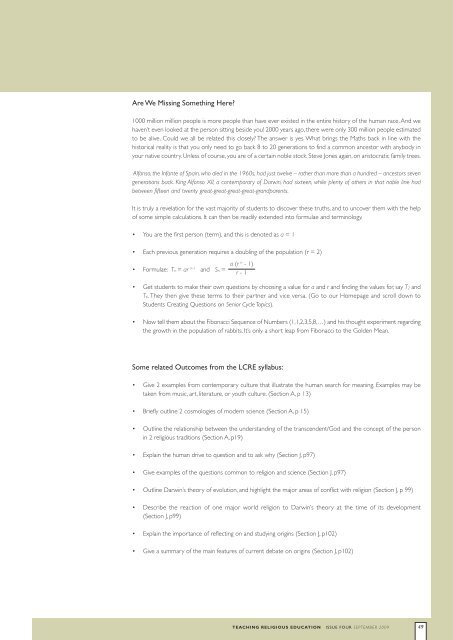TeachingRE Issue 4.pdf - the Second Level Support Service
TeachingRE Issue 4.pdf - the Second Level Support Service
TeachingRE Issue 4.pdf - the Second Level Support Service
You also want an ePaper? Increase the reach of your titles
YUMPU automatically turns print PDFs into web optimized ePapers that Google loves.
Are We Missing Something Here?1000 million million people is more people than have ever existed in <strong>the</strong> entire history of <strong>the</strong> human race.And wehaven’t even looked at <strong>the</strong> person sitting beside you! 2000 years ago, <strong>the</strong>re were only 300 million people estimatedto be alive. Could we all be related this closely? The answer is yes. What brings <strong>the</strong> Maths back in line with <strong>the</strong>historical reality is that you only need to go back 8 to 20 generations to find a common ancestor with anybody inyour native country. Unless of course, you are of a certain noble stock. Steve Jones again, on aristocratic family trees.Alfonso, <strong>the</strong> Infante of Spain, who died in <strong>the</strong> 1960s, had just twelve – ra<strong>the</strong>r than more than a hundred – ancestors sevengenerations back. King Alfonso XII, a contemporary of Darwin, had sixteen, while plenty of o<strong>the</strong>rs in that noble line hadbetween fifteen and twenty great-great-great-great-grandparents.It is truly a revelation for <strong>the</strong> vast majority of students to discover <strong>the</strong>se truths, and to uncover <strong>the</strong>m with <strong>the</strong> helpof some simple calculations. It can <strong>the</strong>n be readily extended into formulae and terminology.• You are <strong>the</strong> first person (term), and this is denoted as a = 1• Each previous generation requires a doubling of <strong>the</strong> population (r = 2)• Formulae: Tn = ar n-1 and Sn =a (r n - 1)r - 1• Get students to make <strong>the</strong>ir own questions by choosing a value for a and r and finding <strong>the</strong> values for, say T2 andT6. They <strong>the</strong>n give <strong>the</strong>se terms to <strong>the</strong>ir partner and vice versa. (Go to our Homepage and scroll down toStudents Creating Questions on Senior Cycle Topics).• Now tell <strong>the</strong>m about <strong>the</strong> Fibonacci Sequence of Numbers (1,1,2,3,5,8,…) and his thought experiment regarding<strong>the</strong> growth in <strong>the</strong> population of rabbits. It’s only a short leap from Fibonacci to <strong>the</strong> Golden Mean.Some related Outcomes from <strong>the</strong> LCRE syllabus:• Give 2 examples from contemporary culture that illustrate <strong>the</strong> human search for meaning. Examples may betaken from music, art, literature, or youth culture. (Section A, p 13)• Briefly outline 2 cosmologies of modern science (Section A, p 15)• Outline <strong>the</strong> relationship between <strong>the</strong> understanding of <strong>the</strong> transcendent/God and <strong>the</strong> concept of <strong>the</strong> personin 2 religious traditions (Section A, p19)• Explain <strong>the</strong> human drive to question and to ask why (Section J, p97)• Give examples of <strong>the</strong> questions common to religion and science (Section J, p97)• Outline Darwin’s <strong>the</strong>ory of evolution, and highlight <strong>the</strong> major areas of conflict with religion (Section J, p 99)• Describe <strong>the</strong> reaction of one major world religion to Darwin’s <strong>the</strong>ory at <strong>the</strong> time of its development(Section J, p99)• Explain <strong>the</strong> importance of reflecting on and studying origins (Section J, p102)• Give a summary of <strong>the</strong> main features of current debate on origins (Section J, p102)TEACHING RELIGIOUS EDUCATION ISSUE FOUR SEPTEMBER 2009 49


